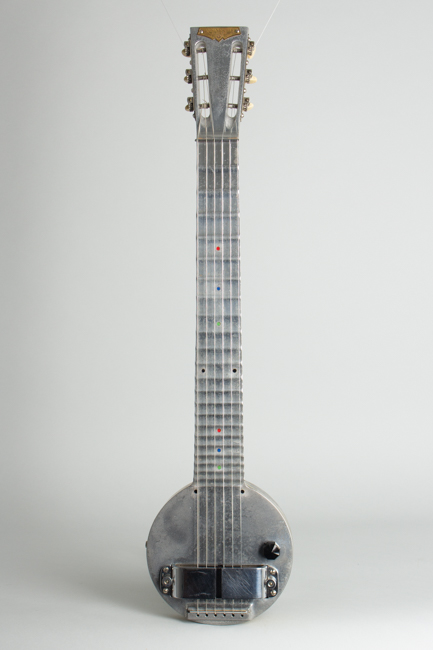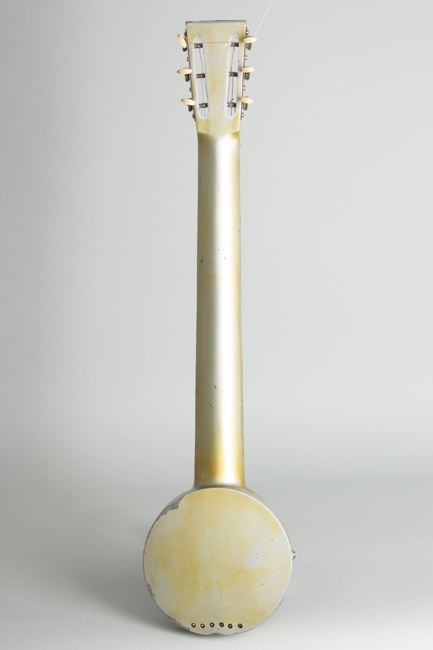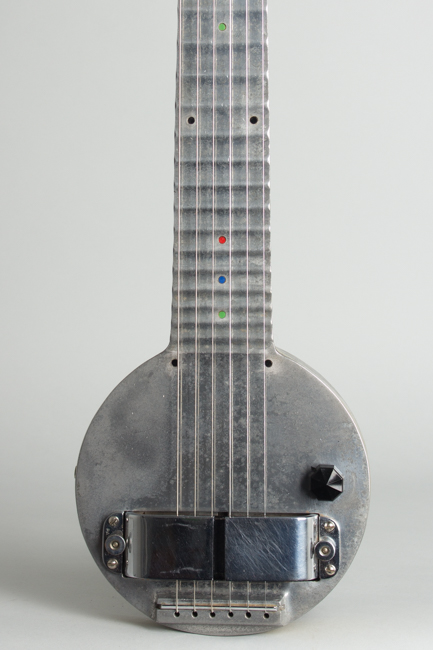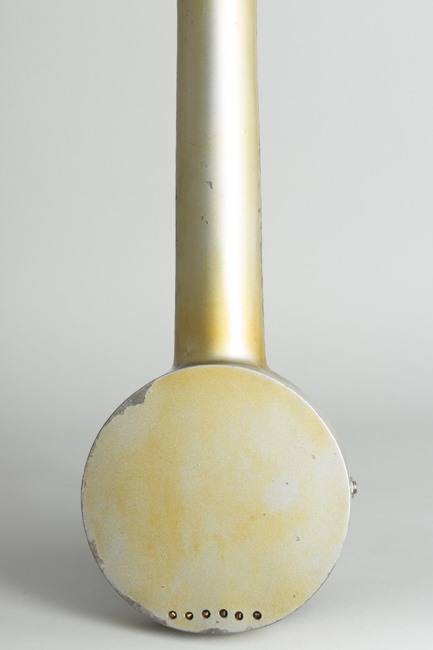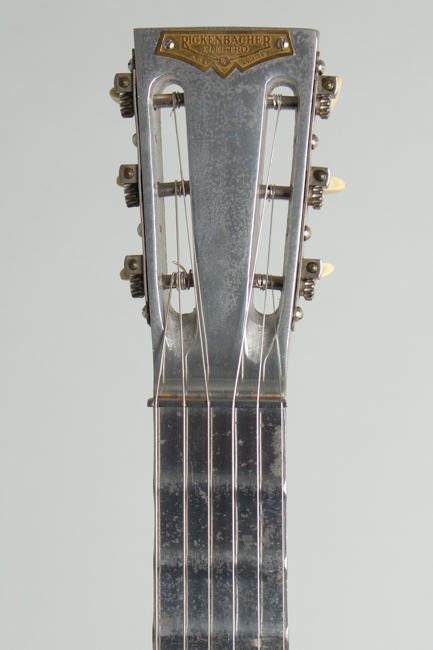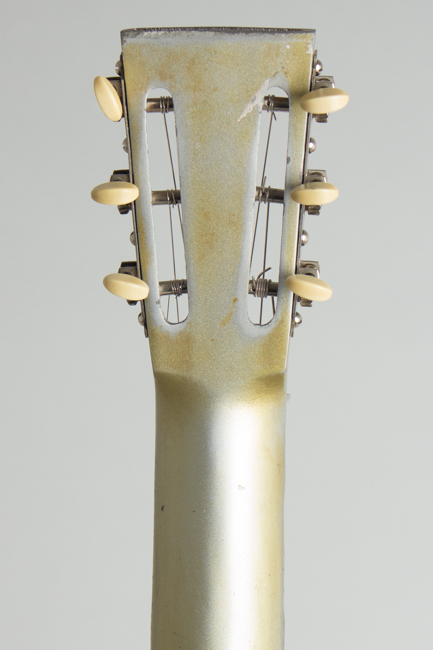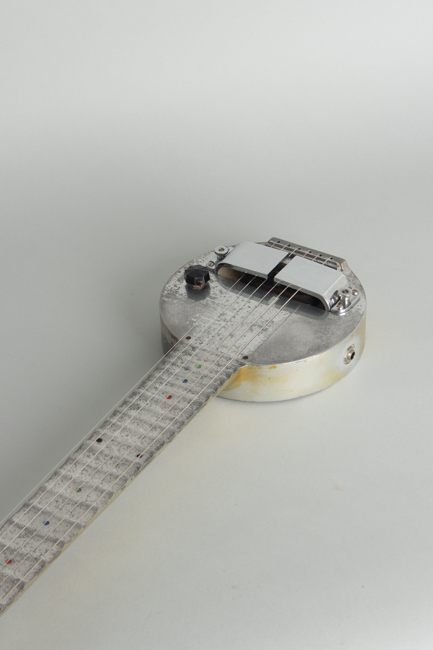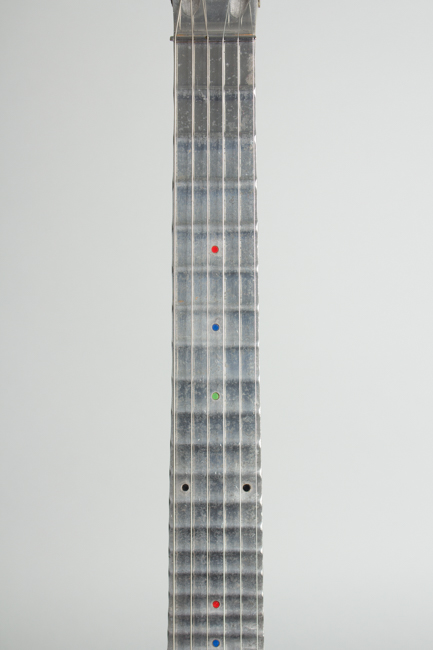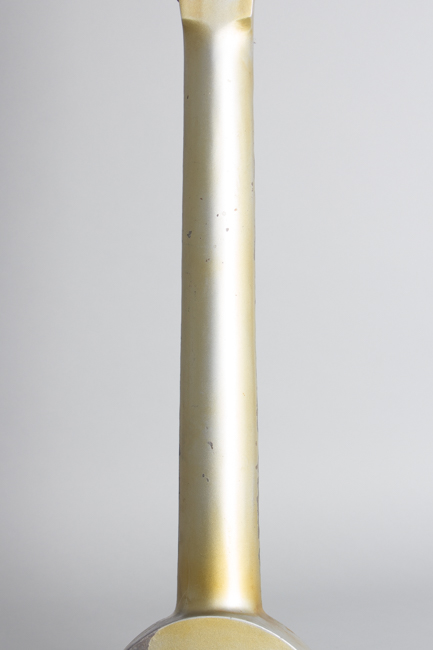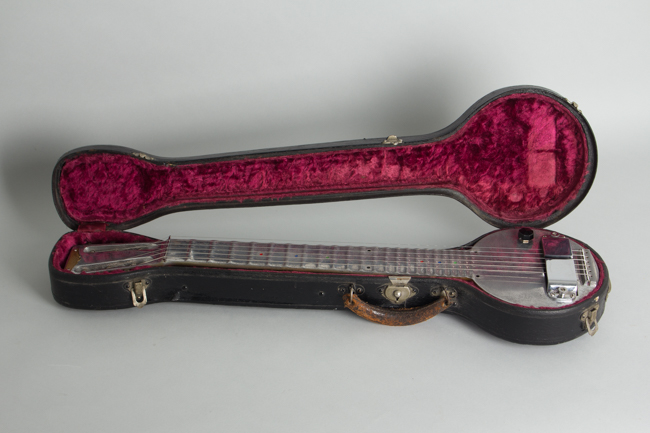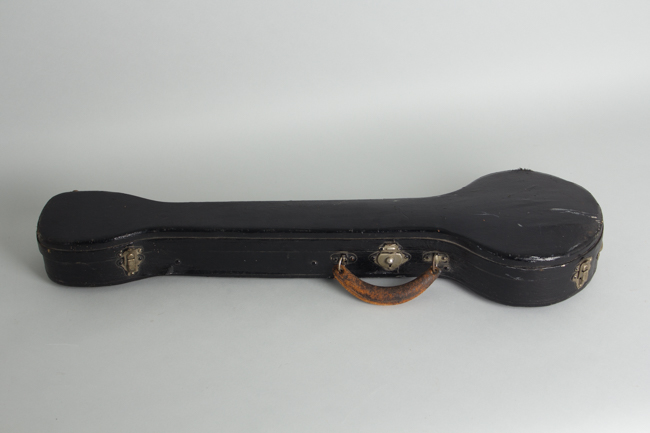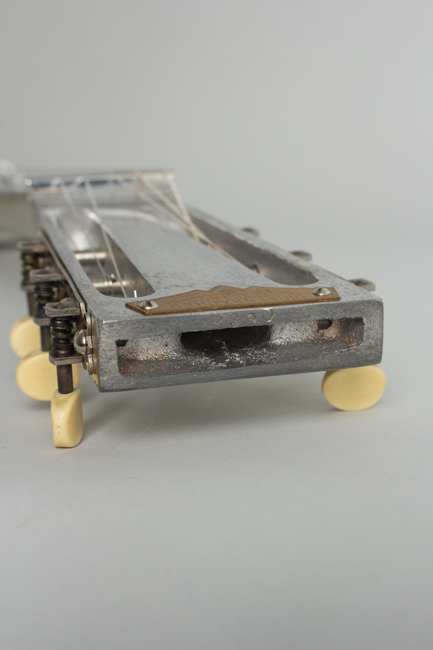Rickenbacker Model A-22 Lap Steel Electric Guitar (1935)
This item has been sold.
Item # 9279
Prices subject to change without notice.
Rickenbacker Model A-22 Model Lap Steel Electric Guitar (1935), made in Los Angeles, serial # B-390, gold enamel and natural aluminum finish, cast aluminum body, original black hard shell case.
The Rickenbacher A-22 Electro Hawaiian Guitar, nicknamed the "Frying Pan" for its distinctive shape is simply one of the most historically important of all 20th century guitars. This design was the first commercially successful electrified string instrument as well as the first solid body guitar. It was the initial carrier of the celebrated pre-war 1 1/2 inch horseshoe magnet pickup, the first electro-magnetic instrument pickup to be perfected and still one of the greatest-sounding units ever. While Rickenbacker went on to produce many other designs, the "Frying Pan" is where it all began for both this California company and electric guitars in general.
The very first few Electros from 1932-3 have no onboard controls, this example has a single volume pot with an octagonal Bakelite knob. The fingerboard is integral with the neck and has raised ridges for frets and green, red, blue and black inlayed dot markers. The entire instrument extremely futuristic for the 1930's, a high deco minimalist design fabricated from a single piece of cast aluminum. The strings run through the body and over a separate chromed metal saddle, through the horseshoe magnet pickup and on over a chromed brass nut to the slotted headstock. Although the A-22 was marketed and almost always used as a Hawaiian guitar, the neck is round-backed and with a different set-up this instrument could have been played Spanish style - something designer George Beauchamp alludes to in the original patent application.
The headstock is fitted with 1920's style open gear strip tuners with grained ivoroid buttons, as seen on older Martin and Gibson guitars. A gold metal name plate mounted there reads "Richenbacher Electro, Los Angeles" with "RE" between mirrored lightning bolts. The serial number stamped on the top edge of the headstock is B-390 marking this one as built after the 1935 introduction of the Bakelite Model B. While the "B" prefix is mostly found on Bakelite guitars (the A-22 and long-scale companion A-25 were usually stamped with an "A" number) the Los Angeles factory was pretty lackadaisical about keeping the sequences exact. Over the years we have seen a number of 1930's Rickenbacker instruments with the "wrong" prefix and some inexplicable sequencing!
This example is all original, fully intact and sounds fantastic. Amazingly enough even 85 years on the guitar itself is still a very fine musical instrument and remains one of the best-sounding steel guitars ever produced. While there will always be some debate as to who made the "Absolute First" electric guitar, the introduction of the Rickenbacker Electro established a market for the amplified instruments, and the company dominated it in these first years. Inventor George Beauchamp's electro-magnetic stringed instrument pickup was by far the best sounding and most successful of the early designs and set the basic pattern form all that have come since. The A-22 remains unique, in some ways as modern as when it was first introduced and certainly one of the most distinctive guitars ever designed.
Overall length is 28 3/4 in. (73 cm.), 7 in. (17.8 cm.) width, and 1 5/8 in. (4.1 cm.) in depth, measured at side of rim. Scale length is 22 1/4 in. (565 mm.). Width of nut is 2 in. (51 mm.).
Overall this is a nicely preserved example of this very rare and sought-after instrument, one of the better early A-22's we have ever seen. There is no serious damage, repair or modification. The original gold lacquer wash finish on the back and sides has general wear but much of it remains intact-on many survivors it is heavily chipped or even removed entirely. In this case there is chipping mostly along the edges of the fingerboard and some moisture damage to the sides where the player's leg was in contact. The bare polished aluminum top and fingerboard show heavier wear from contact with the player's hands, and numerous tiny dings in the top surface from bar impacts.
The amazing and wonderful original shaped case is fully intact with a black paint over coating to the oilcloth covering, with the original leather handle and red plush lining surprisingly well preserved. Many extant examples of these historic early electric guitars have been heavily worn or modified, and at least according to legend many were melted down in the 1940's to reclaim valuable aluminum for the war production market. This is a wonderful original "Frying Pan", played but not abused and with the pickup working perfectly still a delightful instrument to play and hear even aside from its historical value. Excellent - Condition.
The Rickenbacher A-22 Electro Hawaiian Guitar, nicknamed the "Frying Pan" for its distinctive shape is simply one of the most historically important of all 20th century guitars. This design was the first commercially successful electrified string instrument as well as the first solid body guitar. It was the initial carrier of the celebrated pre-war 1 1/2 inch horseshoe magnet pickup, the first electro-magnetic instrument pickup to be perfected and still one of the greatest-sounding units ever. While Rickenbacker went on to produce many other designs, the "Frying Pan" is where it all began for both this California company and electric guitars in general.
The very first few Electros from 1932-3 have no onboard controls, this example has a single volume pot with an octagonal Bakelite knob. The fingerboard is integral with the neck and has raised ridges for frets and green, red, blue and black inlayed dot markers. The entire instrument extremely futuristic for the 1930's, a high deco minimalist design fabricated from a single piece of cast aluminum. The strings run through the body and over a separate chromed metal saddle, through the horseshoe magnet pickup and on over a chromed brass nut to the slotted headstock. Although the A-22 was marketed and almost always used as a Hawaiian guitar, the neck is round-backed and with a different set-up this instrument could have been played Spanish style - something designer George Beauchamp alludes to in the original patent application.
The headstock is fitted with 1920's style open gear strip tuners with grained ivoroid buttons, as seen on older Martin and Gibson guitars. A gold metal name plate mounted there reads "Richenbacher Electro, Los Angeles" with "RE" between mirrored lightning bolts. The serial number stamped on the top edge of the headstock is B-390 marking this one as built after the 1935 introduction of the Bakelite Model B. While the "B" prefix is mostly found on Bakelite guitars (the A-22 and long-scale companion A-25 were usually stamped with an "A" number) the Los Angeles factory was pretty lackadaisical about keeping the sequences exact. Over the years we have seen a number of 1930's Rickenbacker instruments with the "wrong" prefix and some inexplicable sequencing!
This example is all original, fully intact and sounds fantastic. Amazingly enough even 85 years on the guitar itself is still a very fine musical instrument and remains one of the best-sounding steel guitars ever produced. While there will always be some debate as to who made the "Absolute First" electric guitar, the introduction of the Rickenbacker Electro established a market for the amplified instruments, and the company dominated it in these first years. Inventor George Beauchamp's electro-magnetic stringed instrument pickup was by far the best sounding and most successful of the early designs and set the basic pattern form all that have come since. The A-22 remains unique, in some ways as modern as when it was first introduced and certainly one of the most distinctive guitars ever designed.
Overall length is 28 3/4 in. (73 cm.), 7 in. (17.8 cm.) width, and 1 5/8 in. (4.1 cm.) in depth, measured at side of rim. Scale length is 22 1/4 in. (565 mm.). Width of nut is 2 in. (51 mm.).
Overall this is a nicely preserved example of this very rare and sought-after instrument, one of the better early A-22's we have ever seen. There is no serious damage, repair or modification. The original gold lacquer wash finish on the back and sides has general wear but much of it remains intact-on many survivors it is heavily chipped or even removed entirely. In this case there is chipping mostly along the edges of the fingerboard and some moisture damage to the sides where the player's leg was in contact. The bare polished aluminum top and fingerboard show heavier wear from contact with the player's hands, and numerous tiny dings in the top surface from bar impacts.
The amazing and wonderful original shaped case is fully intact with a black paint over coating to the oilcloth covering, with the original leather handle and red plush lining surprisingly well preserved. Many extant examples of these historic early electric guitars have been heavily worn or modified, and at least according to legend many were melted down in the 1940's to reclaim valuable aluminum for the war production market. This is a wonderful original "Frying Pan", played but not abused and with the pickup working perfectly still a delightful instrument to play and hear even aside from its historical value. Excellent - Condition.
